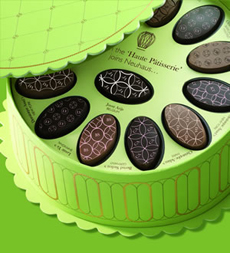GIFT: Neuhaus Haut Pâtisserie Collection
|
You know something is really good when, the minute you finish it you want another.
We don’t know what the chocolates tasted like when the company was founded in 1857; but Neuhaus Chocolates’s new “Haute Pâtisserie” collection is the best Neuhaus chocolate we’ve ever tasted, and stands on the podium with the finest chocolates in the world. “Haut pâtisserie” means high-class pastry, a reference to the nine internationally-reknowned pastry chefs/chocolatiers who each contributed a unique piece to the collection. A pâtissier typically creates a suite of sweets: biscuits (cookies) and macarons, cakes, chocolates, confectionery (caramels, dragées, fondant/nougat, fudge, hard candies, marshmallows, marzipan, pâte de fruit, etc.), ice cream and, of course pastries. |
Neuhaus Haut Patisserie collection. Photo |
|
|
Haut, by the way, is pronounced “oat,” and not “hoat,” as the people responsible for “Haut Goth” or “Haut Look” would have it. The complete pronunciation: oat pah-TEE-suh-ree. THE MOST BEAUTIFUL BOX FOR THE MOST EXQUISITE CHOCOLATES The exquisite round gift box is a keeper. In pale green with textured gold accents, it is may be the nicest package from any chocolatier and evocative of the luxurious boxes that were used to package chocolates in earlier times. It holds 27 chocolates: three pieces from each of nine pastry chefs. It is available with an elegant coordinated bag and an illustrative booklet with the story of each praline for $45.00, at NeuhausChocolate.com. The pralines—what Belgians call bonbons (here’s an explanation of the difference between Belgian and French chocolates), are thick shells of wonderful chocolate. Each pastry chef was guided by his own creative, cultural and gastronomic inspiration. The initials of each chef are worked into the design patterns on the top of each chocolate. Christophe Adam Joost Arijs |
||
 The gift set: box, bag, brochure. Photo courtesy Neuhaus.com. |
Oriol Balaguer Martin Chiffers |
|
|
Raphaël Giot Koji Tsuchija Bernd Sierfert What the French call bonbons and Americans call filled chocolates, Belgians call pralines. It’s a confusing because in France, praline is a caramelized almond and in the U.S., it’s a brown sugar patty with pecans. In fact, Belgian chocolatier Jean Neuhaus started the confusion in 1912, when he developed a process for creating hard shell filled chocolates that he called pralines.
|
||



